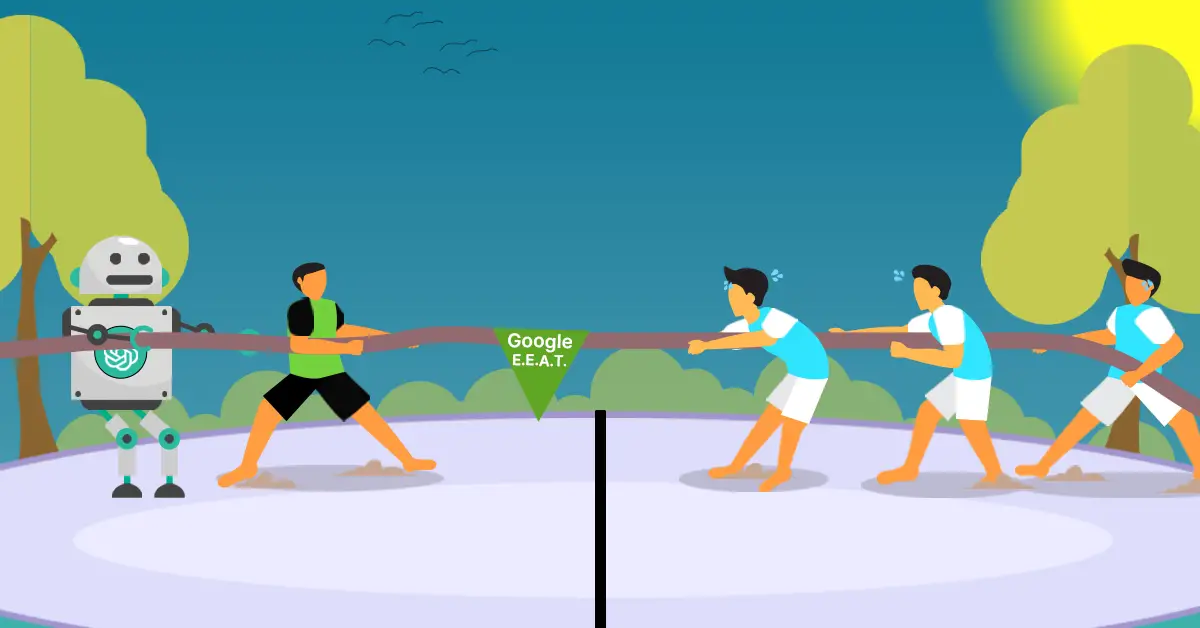
Guest Blog: 4 Ways to Leverage Your Website’s E. E. A.T. Using Generative AI Tools (Part 1)
Get helpful updates in your inbox
The following content was contributed by Saleh Ahmed, Ezoic publisher and founder of Rank Wizards. You can find part 2 here.
TL; DR;
- Using AI, you can find loose ends in your content to demonstrate more E.E.A.T. in them.
- You can combine search queries and competitor content data into a 360-degree content structure using AI.
- AI can help choose the best writers for your niche, and the best topics to write for each of them.
- You can create topical clusters from competitors’ sitemaps using AI, and add your original keyword research to it.
What Is E.E.A.T. and What Does It Mean?
Any SEO is aware of what the letters E.E.A.T. means. But to justify what we discuss throughout the content, we need to revisit the definitions. At least, the content aspects of it.
Experience
Regardless of some exceptions, the first ‘E’ seeks a ‘first hand’ or ‘life experience’ on the topic that the author is writing on. In other words, the content should sound like it’s being written by someone with first-hand knowledge derived from real-life experience.
| Query | Good ‘Experience’ | Bad ‘Experience’ |
| “My grandfather stopped eating” | The author is a professional caregiver with years of real life experience | There’s no mention of who’s the author and what experience he/she has in caregiver or nursing |
| “How to make savings plan for retirement” | The author is a professional caregiver with years of real-life experience | Author is someone who’s not into retirement plans in real life |
Expertise
This refers to how ‘credible’ the author is in writing on a topic, especially if it’s a YMYL (Your Money or Your Life) topic.
If you look at it from a content website owner’s perspective, a perfect example is- if your writer is writing on the nutritional value of a fruit, he/she must have either an academic or professional standpoint on Nutritional Science.
| Query | Good ‘Expertise’ | Bad ‘Expertise’ |
| “How to fill out income tax forms” | Author is a certified lawyer with a specialization in income tax laws and regulations | Content is a scrapped collection(without prior verification) of what other websites have published |
| “Should baby strollers be banned?” | Author is someone who’s raised children in person and possesses a professional experience on federal laws/regulations regarding consumer goods. | Author who’s just experienced raising children of her/his own. |
Authoritativeness
Being familiar with a topic, and being an authority on a topic are totally different grounds to speak from. This letter ‘A’ indicates that, if you’re writing about something that can affect one’s life, you must be a subject matter expert. Other content that you write about on your websites and all across the internet are important data points for justifying your authoritativeness.
| Query | Good ‘Authoritativeness’ | Bad ‘Authoritativeness’ |
| “Can you fly drones in restricted areas?” | Someone who has been writing about drones a lot on his/her own websites, and across other user-generated forums, communities, and social media. | Someone who just owns a drone, and have been tested it a few time in a particular restricted area |
Trustworthiness
Trust is an aggregation of Experience, Expertise, Authoritativeness, and many other factors. Trust might not be equally prioritized for all kinds of niches. But when your site is one of those YMYL topics, this can make or break your SEO game.
| Query | Good ‘Trustworthiness’ | Bad ‘Trustworthiness’ |
| “Buy 30L backpacks in canada” | An e-commerce website with tons of positive customer reviews, clear customer service policies, and has been around for years. | “Buy 30L backpacks in Canada” |
Google Search Raters Guideline and Why It’s Important
Throughout this article, we’ll refer to a number of sources on our way to feed AI tools to possibly increase our E.E.A.T. And the search rater’s guideline tops the list.
This is a guideline for Google’s search raters so that they understand where Google wants the search to go.
Therefore, the closest information to the ranking factors we have is the demonstration of how Google ‘wants’ the SERP to be. They might not be able to bring it all into reality, but it’s still an invaluable resource.
If you want to keep up with the backend process of why and how we’re trying to improve E.E.A.T. using AI, these sections from the search rater’s guide can warm up the ground for you-
- 3.4 Experience, Expertise, Authoritativeness, and Trust (E-E-A-T)
- 4.5 Untrustworthy Web Pages or Websites
- 3.0 Overall Page Quality Rating
- 4.7 Examples of Lowest-Quality Pages
Among other important resources, we’ve used for this guide on August 2022 helpful content update, the general helpful content guideline, google’s spam content policy, etc.
Part 1 of 4: Content Level Improvement
We’ll start off with a few ideas to improve E.E.A.T. at the content level of your website.
Find Loose Ends to Show Off More Experience/Expertise in Content
Here, we will use some questions from Google’s helpful content guidelines to find loopholes in content. Later on, we’ll ask it to rephrase those weak sentences in a more E.E.A.T.-friendly way.
Start with this prompt-
Prompt 1
“Act as a Google search rater and create 7 parameters of justifying content based on these questions-
Does the content provide original information, reporting, research or analysis?
Does the content provide a substantial, complete or comprehensive description of the topic?
Does the headline and/or page title avoid being exaggerated or shocking in nature?
Does the content present information in a way that makes you want to trust it, such as clear sourcing, evidence of the expertise involved, and background about the author or the site that publishes it, such as through links to an author page or a site’s About page?
Is this content written by an expert or enthusiast who demonstrably knows the topic well?
Does the content have any easily-verified factual errors?
Would you feel comfortable trusting this content for issues relating to your money or your life?”
Here are the outputs from different AI tools:
Chat GPT-
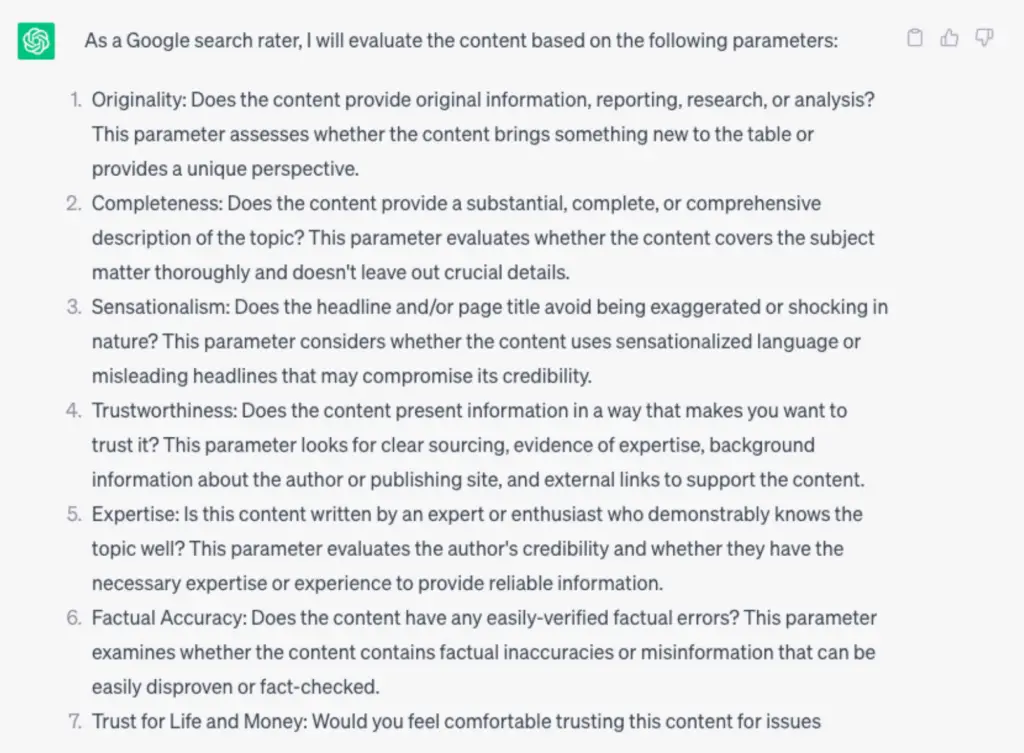
BARD-
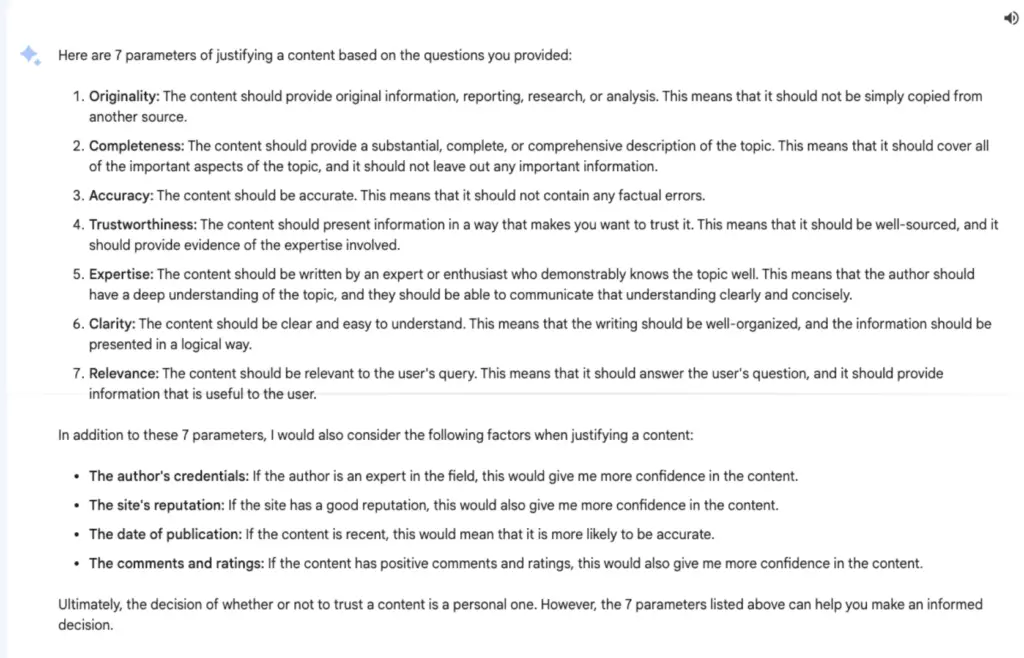
Perplexity AI-
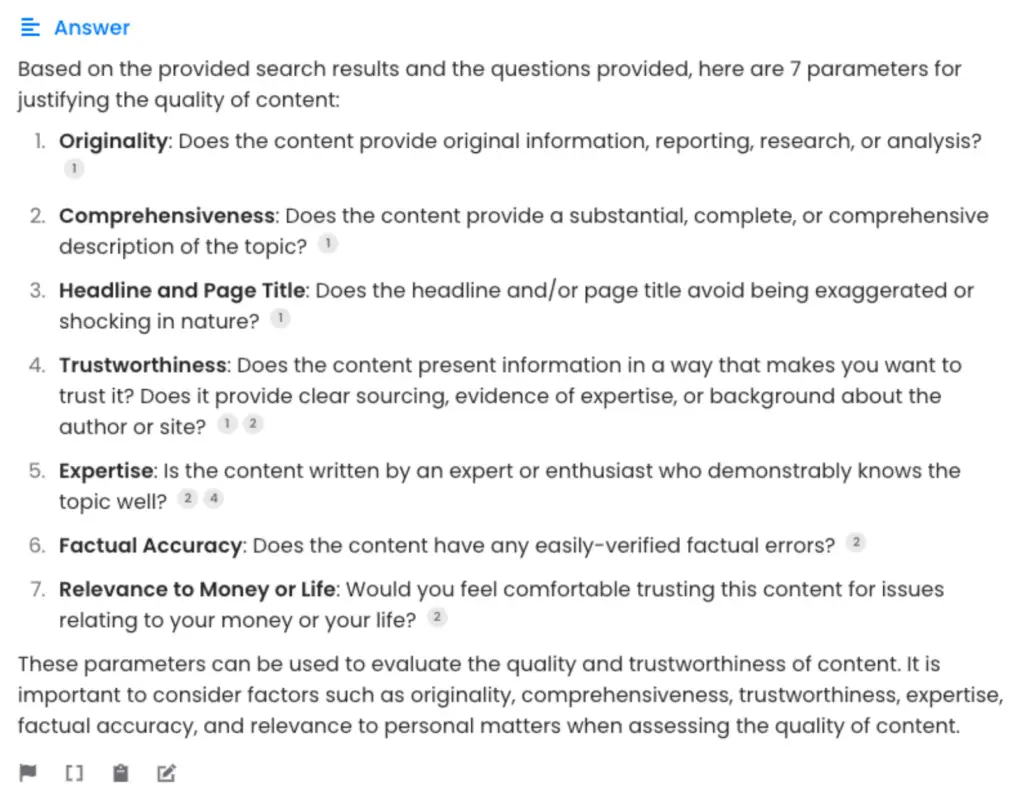
Prompt 2
“Now, rate this content out of 10 for each of the 7 metrics-
<article text> ”
And for perplexity AI, since it has a prompt character limit, you can replace the article text with a live link, like this-
“Now, rate this content out of 10 for each of the 7 metrics-
<article URL> ”
The output will be like these:
Chat GPT-
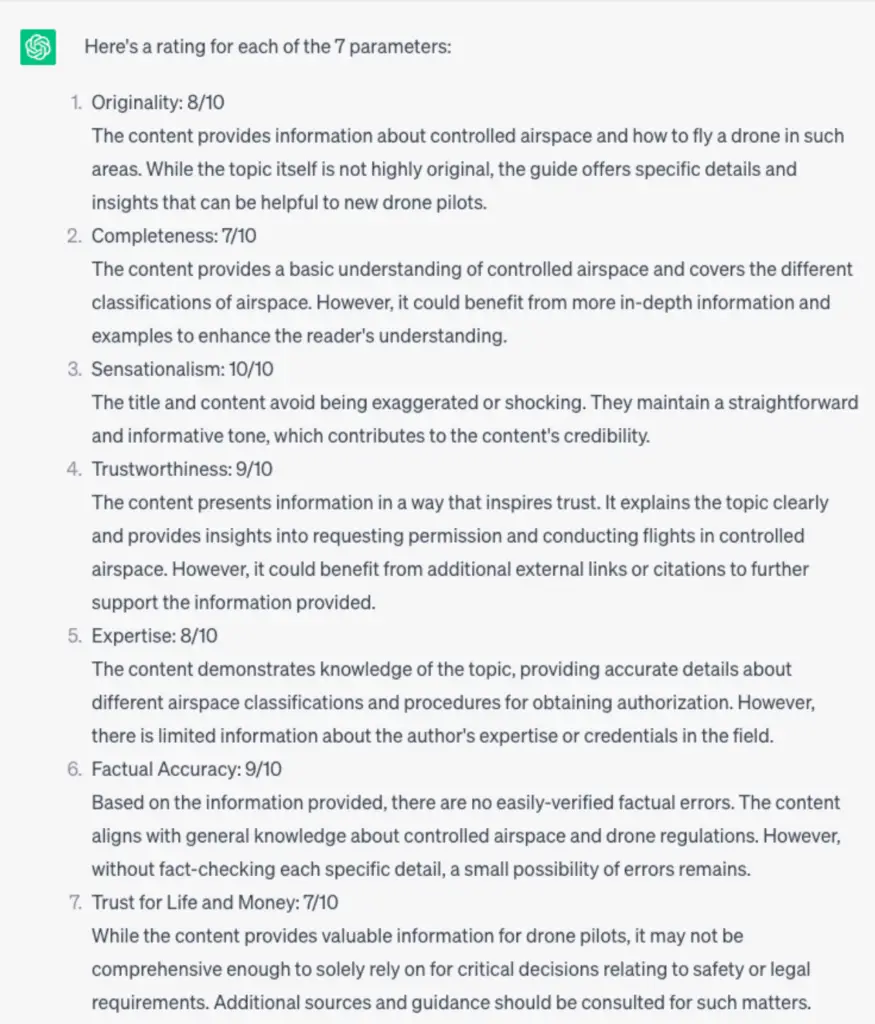
BARD-
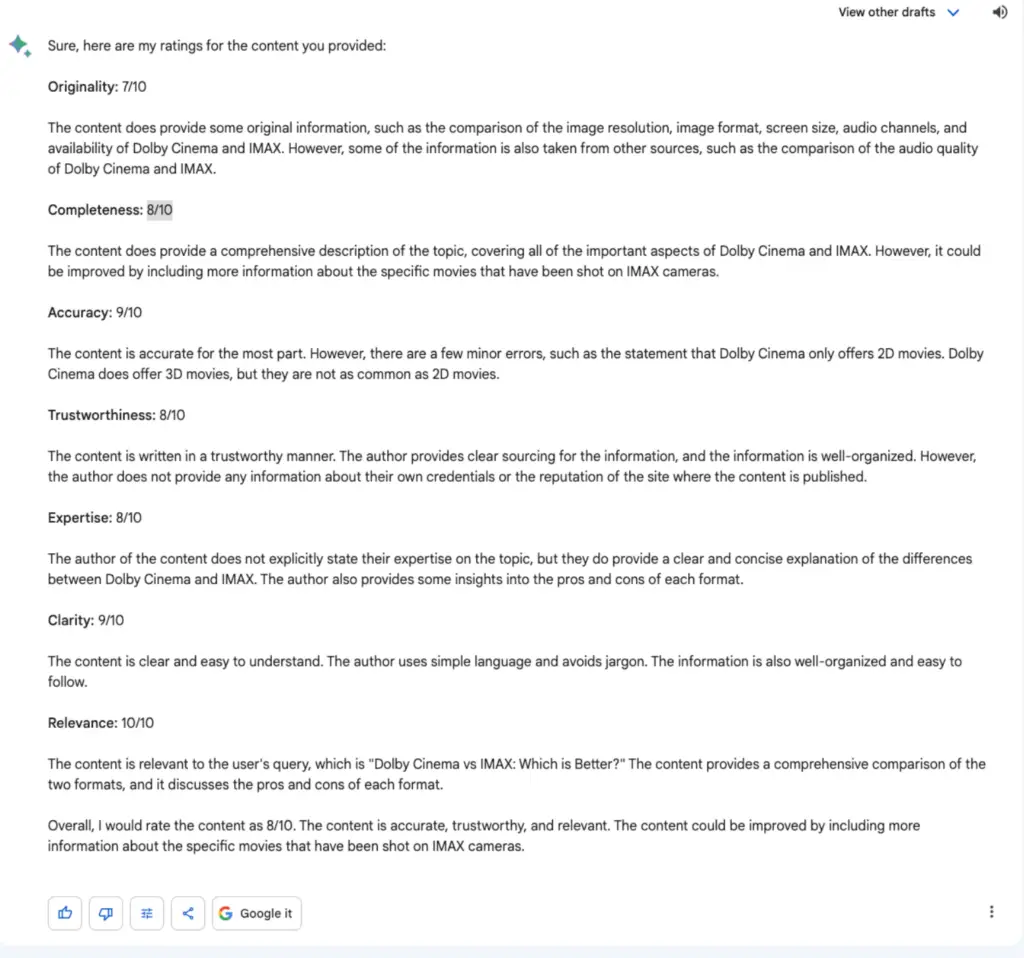
Perplexity AI-
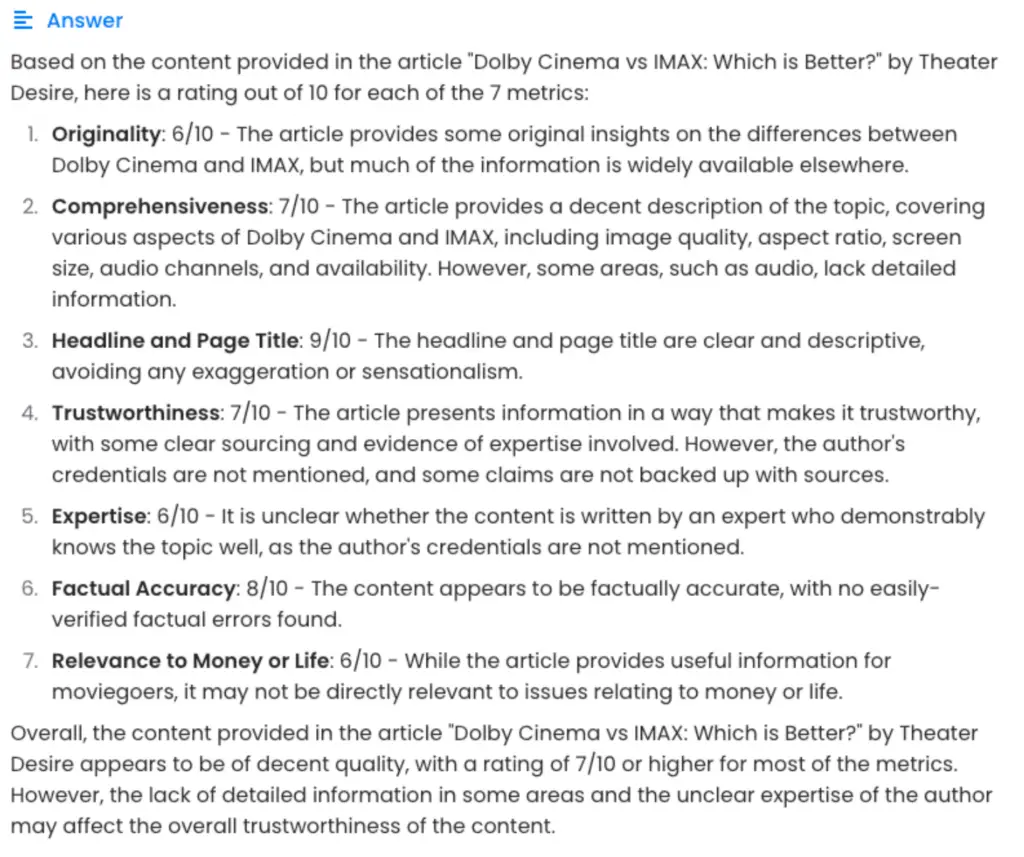
Now, point out those 2 or 3 metrics where your content has performed 7/10 or lower. And it is to break down why they ranked it low on those metrics.
Note that, usually Bard is pretty generous when it comes to scrutinizing articles based on those metrics. So for the next prompts, we’re only going to stick to Chat GPT and Perplexity AI.
Now, go and ask it to point out why the article’s been rated low for the lowest metrics (i.e. Originality, expertise, etc).
Prompt 3
“You have rated low at the metrics of Originality and Expertise. Can you point out which parts of the article can be improved and what to improve in those parts so that it gets a better score at Originality and Expertise?”
Now, you’ll get a theoretical example of what the content lacks and how they are connected to those low-scored metrics.
Chat GPT-
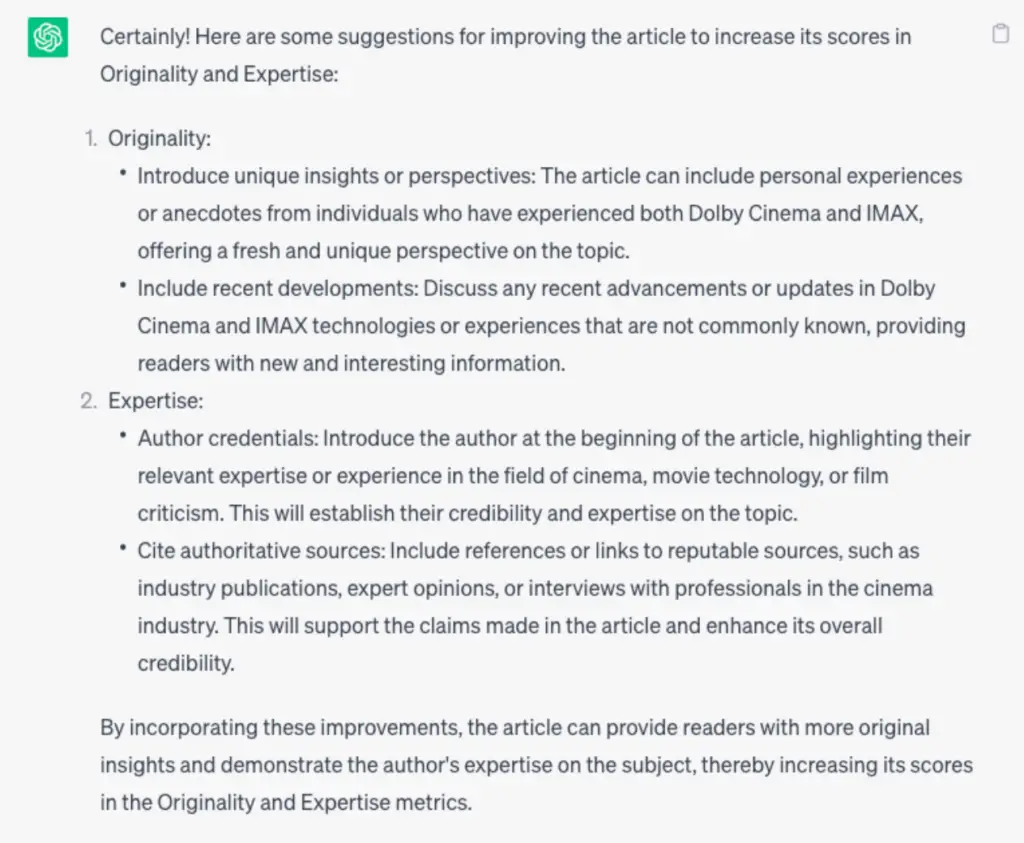
Perplexity AI-
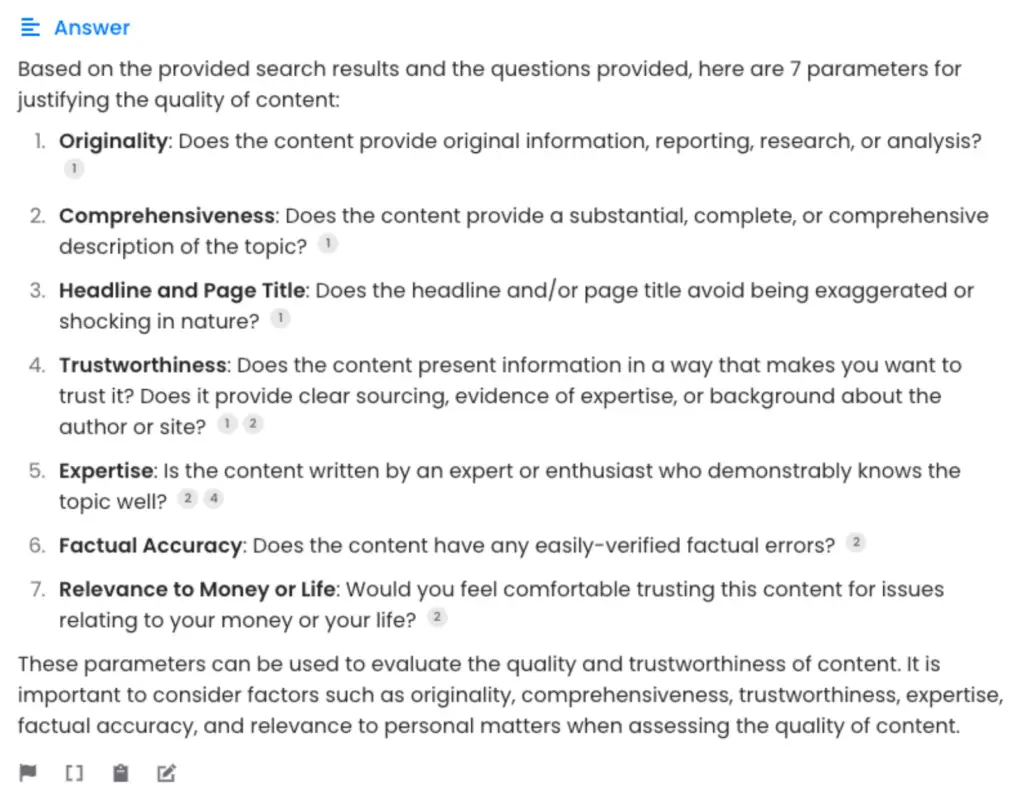
But since we want a more detailed and demonstrated example, we’re going to ask it to pick up those weak parts of the articles and show us how it should be done so that it overcomes those lackings.
Prompt 4
For Chat GPT-
“Select some paragraphs from the article and suggest a modified version as per what you have suggested to improve originality and expertise. The writer’s persona should be a person who has first-hand experience with the topic of the article. ”
For Perplexity-
“Select some paragraphs from this article(<article URL>) and suggest a modified version as per what you have suggested to improve originality and expertise. The writer’s persona should be a person who has first-hand experience with the topic of the article. Mark the original paragraph as ‘before’ and the modified paragraphs as ‘after’. And pick up at least 5 such before-after pairs from the content given.”
Now here you’ll get a head-to-head comparison of what those weak parts of the content are, and how they should be according to the scores of the low-rated parameters.
Chat GPT-
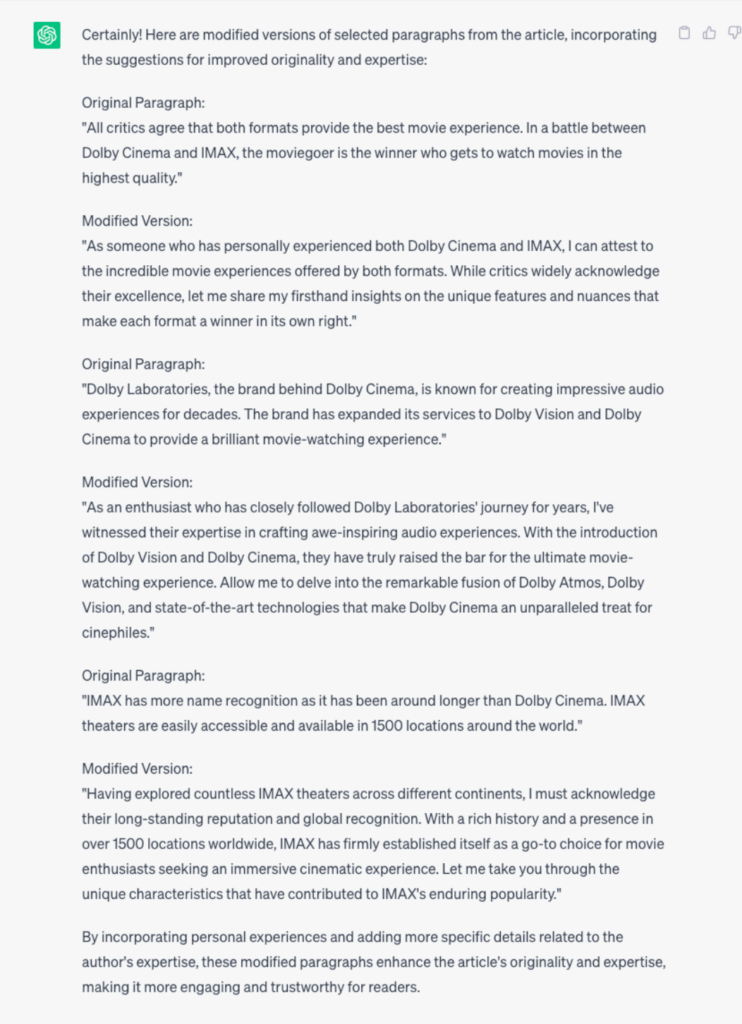
Perplexity AI-
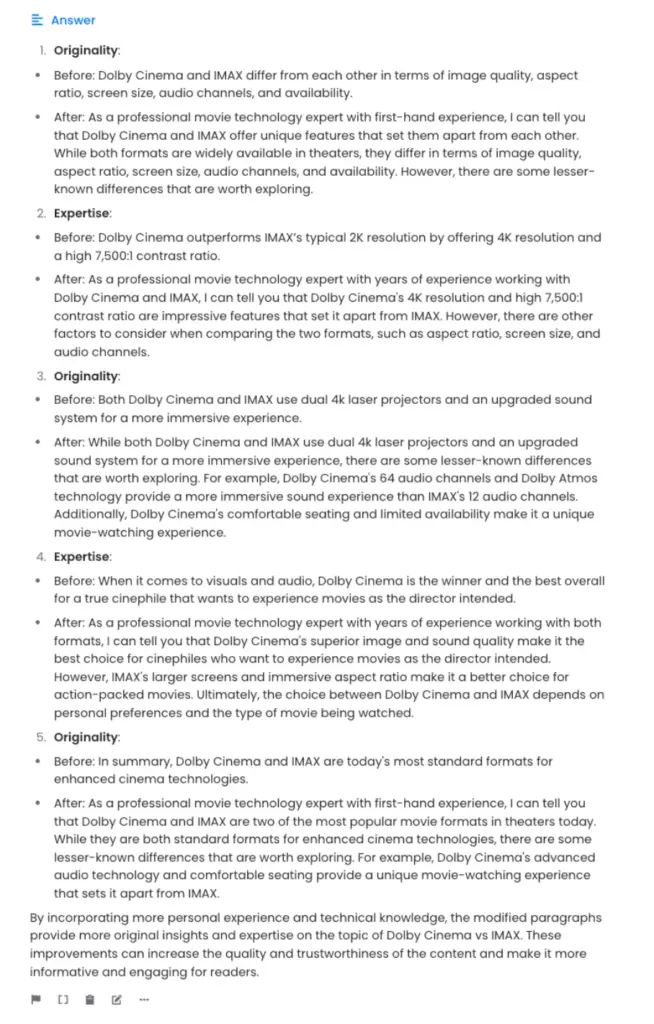
Examples 1: How to Fly Your Drone in Controlled Airspace
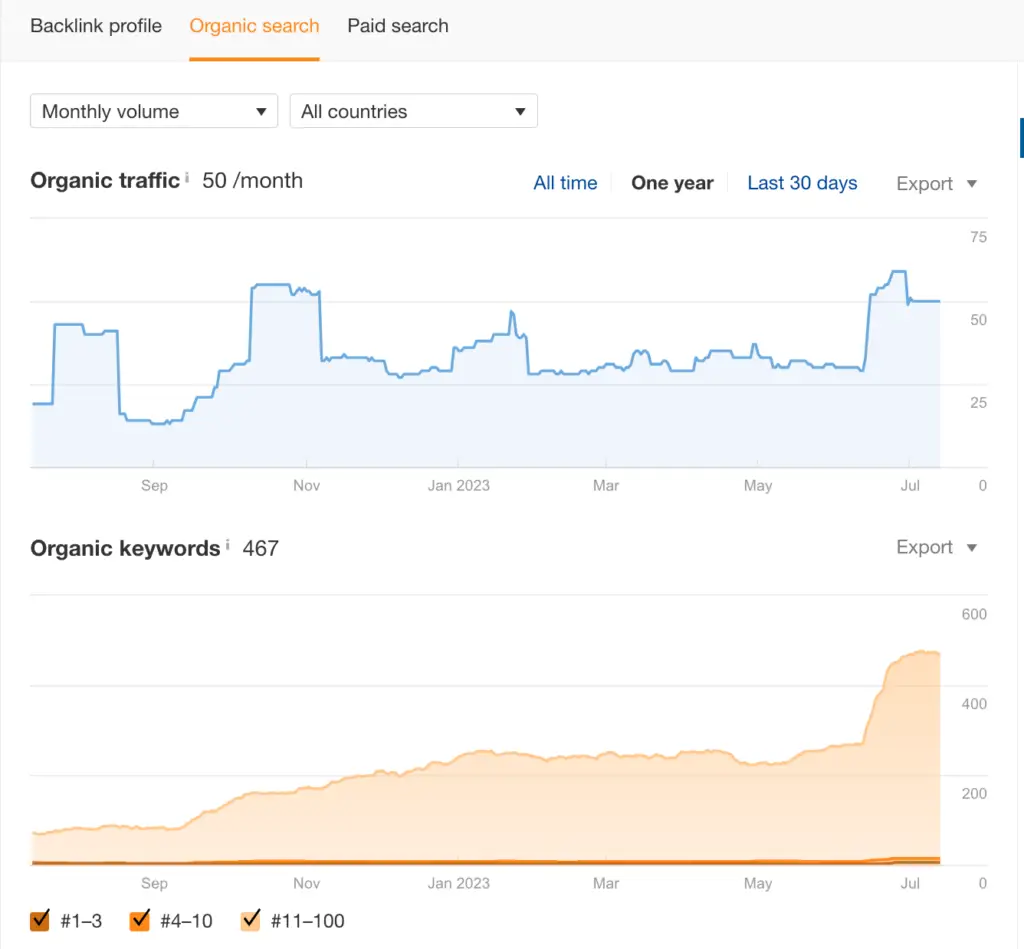
| Metrics | Chat GPT | Bard | Perplexity AI | Forefront Chat |
| Originality | 8/10 | 9/10 | 7/10 | 8/10 |
| Completeness | 7/10 | 10/10 | 9/10 | |
| Comprehensiveness | 8/10 | |||
| Headline and Page Title | 9/10 | |||
| Accuracy | 9/10 | 9/10 | 9/10 | 9/10 |
| Trustworthiness | 9/10 | 9/10 | 8/10 | 9/10 |
| Expertise | 8/10 | 10/10 | 9/10 | 8/10 |
| Clarity | 10/10 | |||
| Relevance | 10/10 | |||
| Sensationalism | 10/10 | 10/10 | ||
| Trust for Life and Money | 7/10 | 7/10 | 7/10 |
These scores imply that this is an actually good article. And if you look at the organic metrics, you’ll find that it’s actually doing good for whatever search volume this keyword has.
Now, let’s try an article with significantly less quality in it:
Example 2: Dolby Cinema vs IMAX: Which is Better?
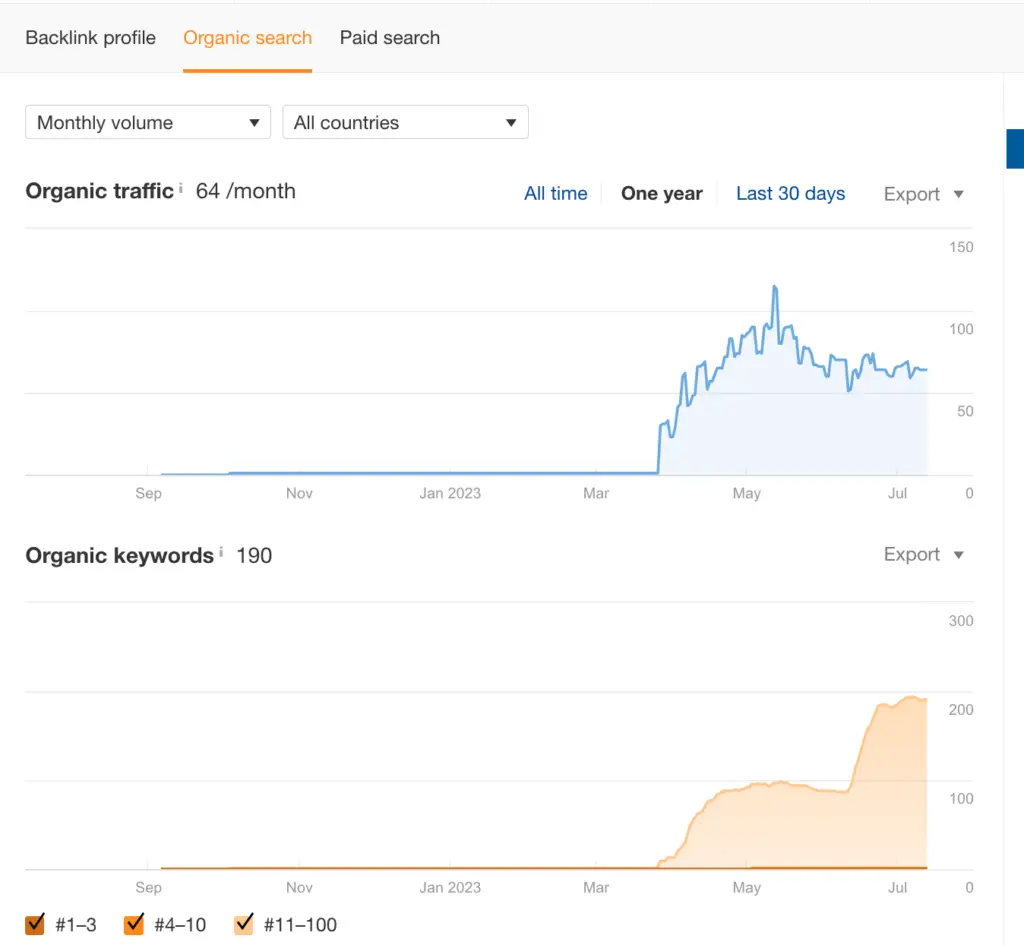
| Metrics | Chat GPT | Bard | Perplexity AI |
| Originality | 6/10 | 7/10 | 6/10 |
| Completeness | 8/10 | 8/10 | |
| Comprehensiveness | 7/10 | ||
| Headline and Page Title | 9/10 | ||
| Accuracy | 8/10 | 9/10 | 8/10 |
| Trustworthiness | 7/10 | 8/10 | 7/10 |
| Expertise | 6/10 | 8/10 | 6/10 |
| Clarity | 9/10 | ||
| Relevance | 10/10 | ||
| Sensationalism | 9/10 | ||
| Trust for Life and Money | 7/10 | 6/10 |
Since the scores are low enough to dig further for scopes of improvement, let’s try Prompts 3 and 4 on it.
Prompt 3 brings out why AI tools think it deserves sub-par ratings in a few metrics. And here’s what it looks like:


And finally, Prompt 4 brings down a head-to-head comparison between how particles are now, and how they should be written.
Their results come in different packaging but do the same job.
Chat GPT-
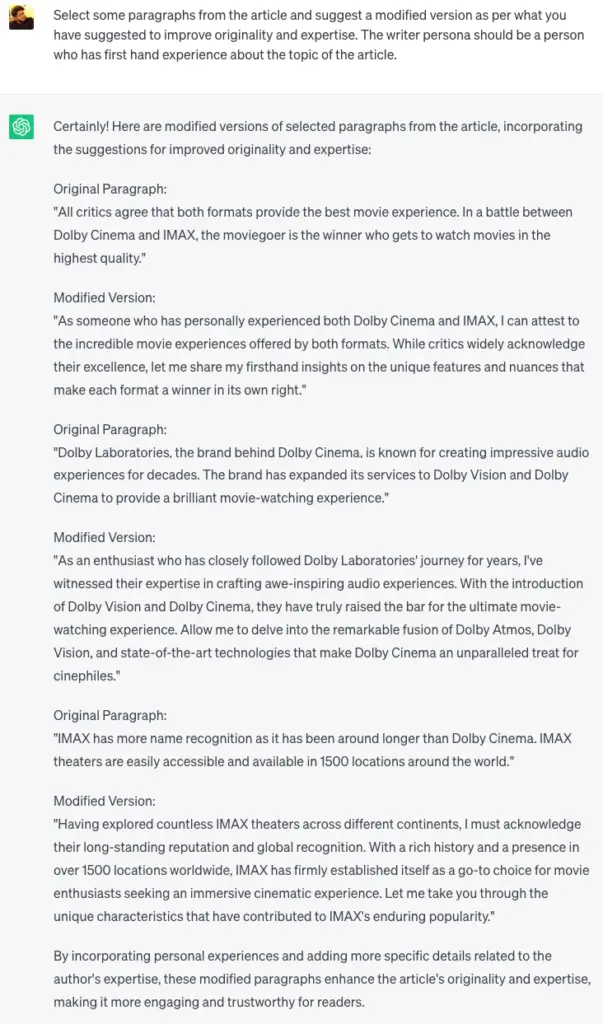
And Perplexity does this-
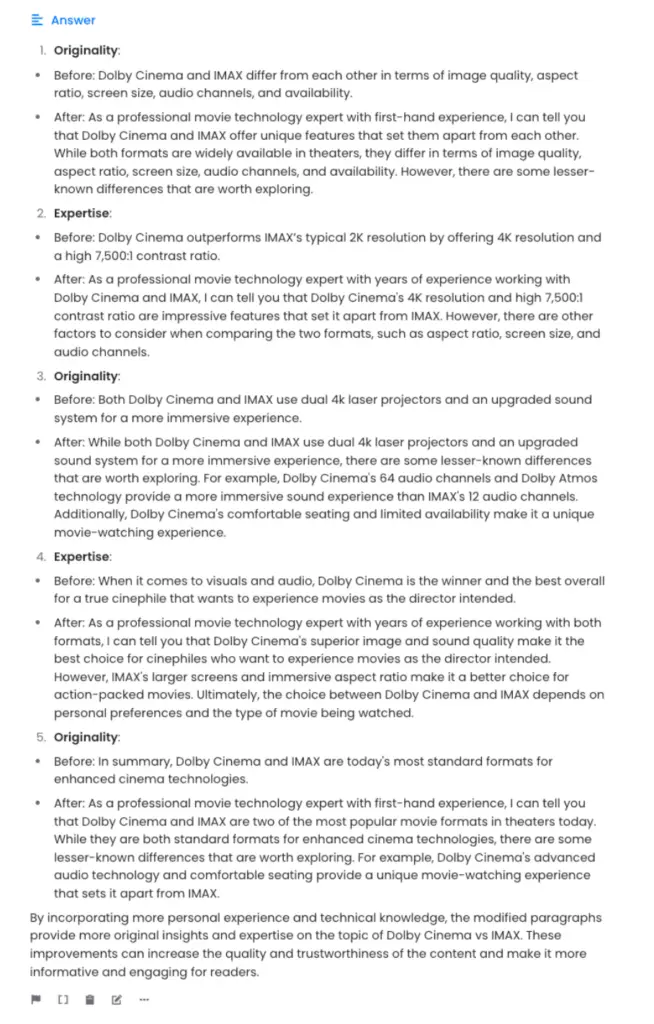
Once you’re done with all these, you’ll have direct editing suggestions in hand, that you can take inspiration from regarding writing tone, perspective, establishing references, and other EEAT materials.
Make Content ‘People First’ With Maximum Coverage
It’s always recommended to create contents that prioritize what people want to see in content. And this always reflects on what search queries people are searching around a main query.
Plus, if you use the generic capability of internet searching tools like Perplexity AI, this will add some more textures to the content.
Finally, you can pinpoint some SERP competitors and add more topics to your content structure.
In this section, we’ll create a structure this way for the topic ‘How to charge lipo batteries’.
At first, we’ll go and stack up some secondary keywords(that are potential sub-topics) randomly-
| Main Keyword | Secondary Keywords |
| how to charge lipo battery | how to charge lipo battery with mobile charger how to charge a lipo battery without a charger how to charge a lipo battery for the first time how to charge 7.4v lipo battery how to charge lipo battery with USB li-po battery charging tips how to charge lipo battery with traxxas ez peak how to charge lithium ion battery what amp to charge lipo batterywhat amperage to charge lipo battery what voltage to charge lipo battery what rate should i charge my lipo battery at what is storage charge for a lipo battery what voltage should i charge my lipo battery at what voltage to charge 12v lipo battery what is the best way to charge a lipo battery when to charge lipo battery can you leave a lipo battery charged can i charge lipo battery with li-ion charger can i charge lipo battery with nimh charger can you charge a li ion battery with a lipo charger can you charge a dead lipo battery can you charge a lipo battery with a normal charger can you charge a lipo battery without a balancer can you half charge a lipo batteryhow fast can you charge a lipo battery can you storage charge a fully charged lipo battery can i charge a lifepo4 battery with a lipo charger |
Now, we’ll prompt chat GPT to organize the keywords into a meaningful content structure-
Prompt 1
“Pretend to be an SEO content structuring expert. Create a content structure on the topic of “How to Charge Lipo Battery”. While creating the structure, follow each of these rules-
1. Must use the given secondary keywords as sub-topics.
2. Make sure the sub-topics have a natural, and relevant sequencing.
3. The headings will be marked as H2, H3, and H4, where H1 will be “How to Charge Lipo Battery”
4. No detailing is needed under each of the headings. Just the name of the headings, and how many words each of the headings should be of.
List of secondary keywords-
how to charge lipo battery with a mobile charger
how to charge a lipo battery without a charger
how to charge a lipo battery for the first time
<add all other secondary keywords here>”
It’ll come up with a pretty decent structure with a proper h-tag hierarchy in it-
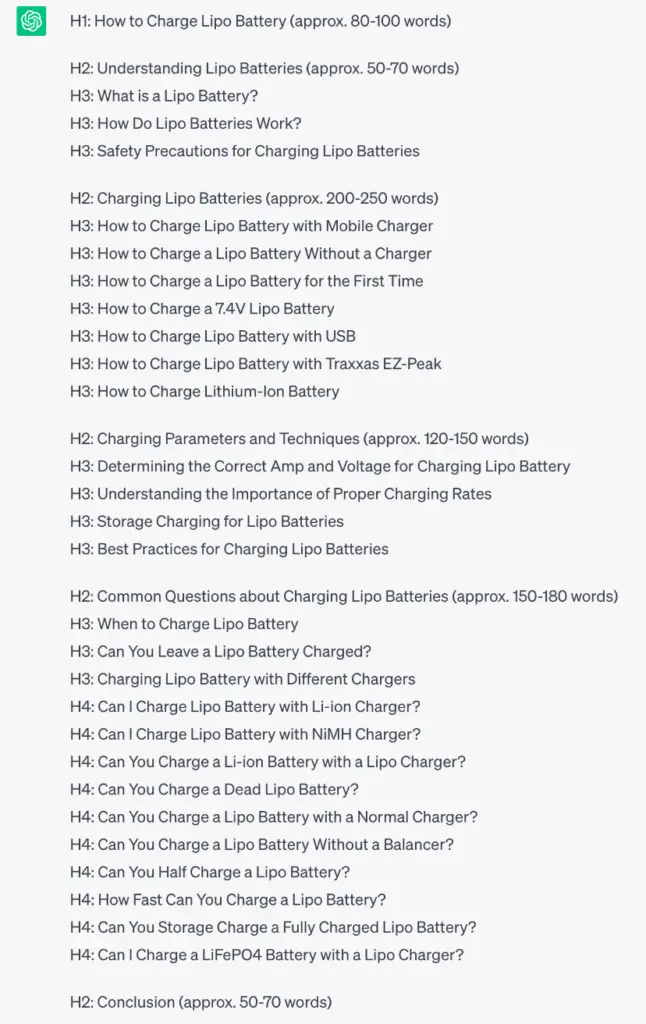
Now, we’ll take the structure to Perplexity AI and ask it to make a list of what topics or subtopics are missing in it compared to what data is available on the internet. This will give the structure completeness.
Prompt 2
“This is the structure of an article about ‘How to charge Lipo Batteries’.
Based on the internet, what are the topics/subtopics that can be added to this content? It’s mandatory that you suggest only those topics/subtopics that are currently not covered in the structure.
Content Structure-
<structure from chat gpt>”
It’ll make a list of some topics that are actually not covered in the chat gpt structure. Looks like this-
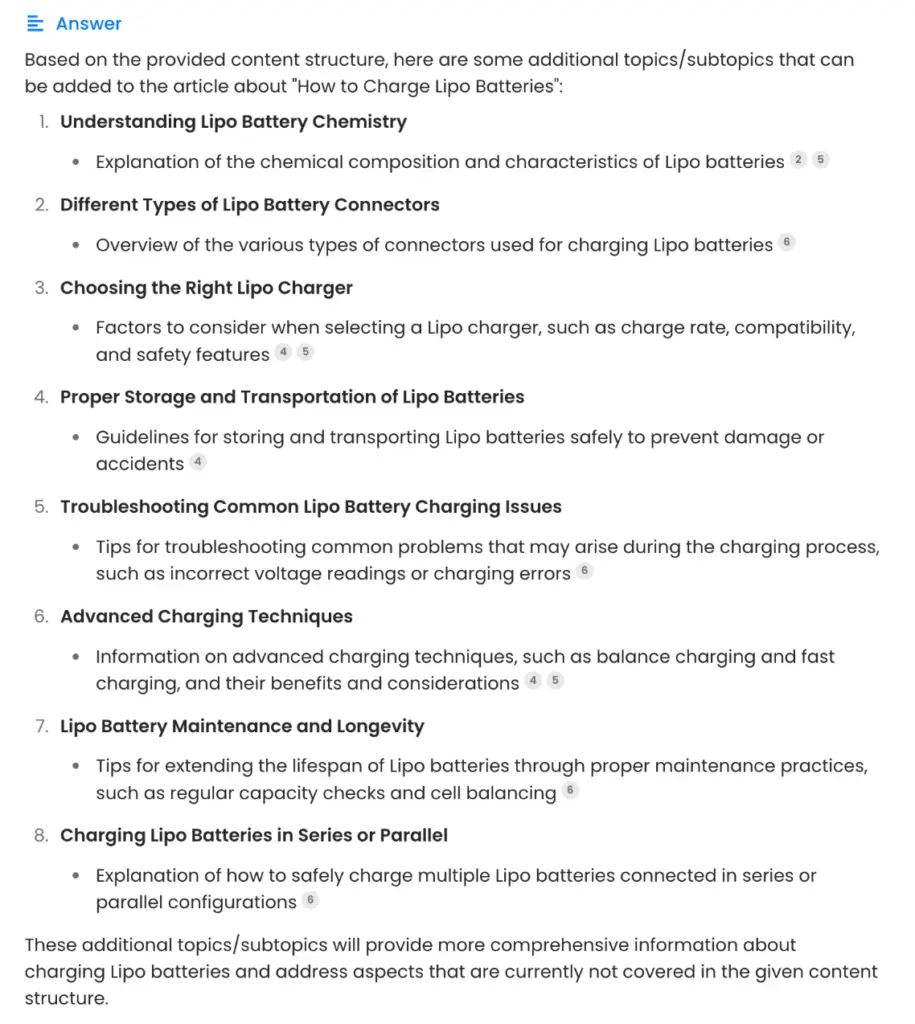
Now, we’ll also ask it to blend with the current structure and make sure the blend is natural and contextual. It also asks the tool to mark the topics that’s been newly added. To keep it simple, we’re pasting the chat GPT structure again in this prompt.
Prompt 3
“Now add all of these additional topics/subtopics as H2/H3/H4 into the structure given below. You can rearrange the provided structure if needed.
Please make sure that-
1. The transition from each topic to the next has to be natural and contextual.
2. There can not be any direct or indirect repetition of topics throughout the content.
3. The new topics/subtopics you’ll be adding on top of the old structure, have to be marked by an asterisk(*)
Given structure-
<structure from chat gpt>”
As output, you’ll have a more wholesome structure now, which includes both secondary keywords(as topics) and other popular topics from the internet.
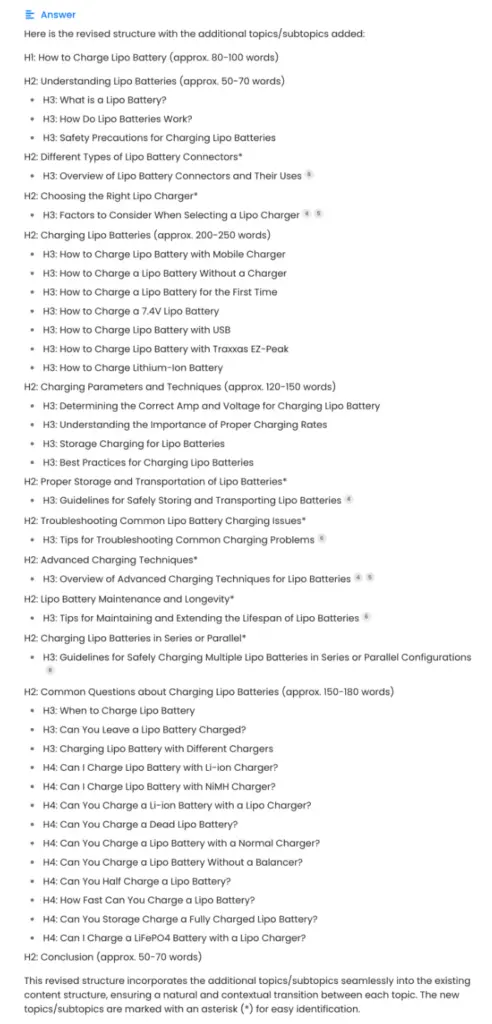
Now, to be certain about whether we’re actually ahead of the competitors on the first page of SERP, we’re going to give Perplexity AI a list of competitors and ask it to come up with some original materials for the content.
Prompt 4
“Now add 3-4 subheadings into the structure that are completely unique and original than these articles-
https://www.makeuseof.com/how-to-charge-a-lipo-battery/
https://fpvfc.org/beginners-guide-to-lipo-batteries
https://www.eurorc.com/page/95/how-to-use-and-charge-lipo-batteries
https://hobbyking.com/en_us/blog/how-to-charge-lipo-battery-for-beginners
https://robocraze.com/blogs/post/how-to-charge-lipo-battery
https://www.rchelicopterfun.com/charging-rc-lipo-batteries.html
The subheadings can be about table, chart, comparison, checklist and any other kind of information. Make sure the sub-heading reflects what it contains within.”
The outcome will be some really interesting topics that might not be in any of your top 10 competitors. This will give the article a touch of original materials within it.
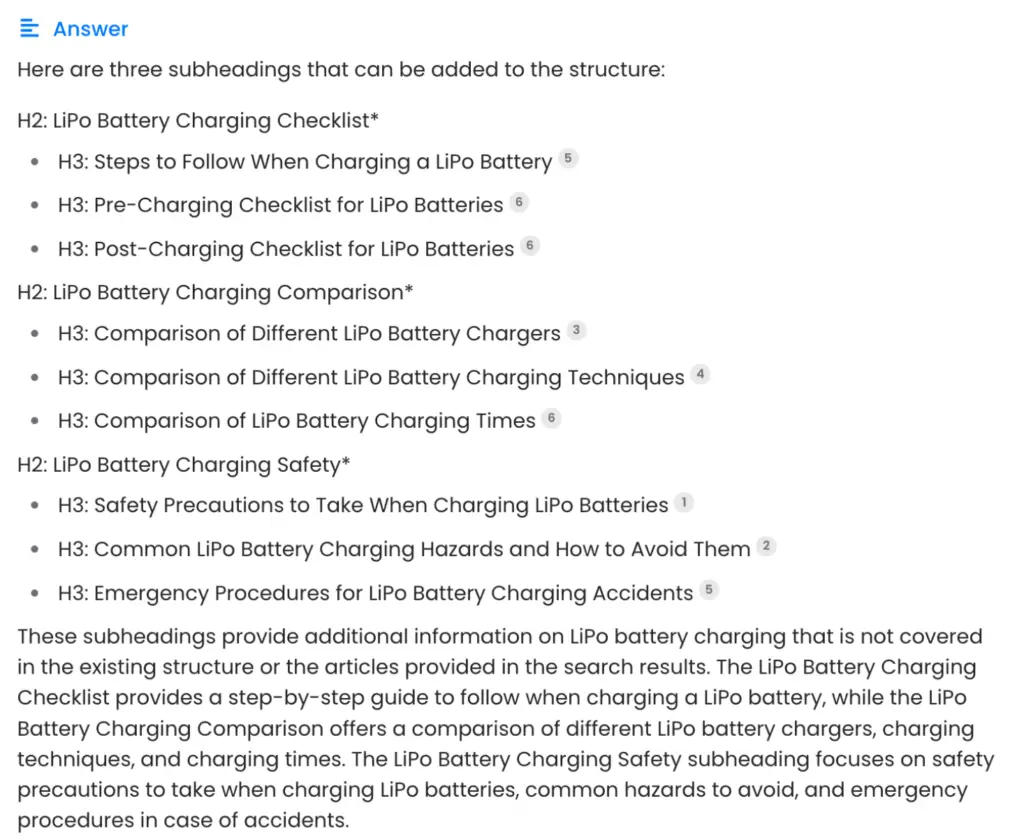
Part 2 of 4: Author And Website Reputation Improvement
Author-level data points are one of the most frequently mentioned factors in Google’s search rater guideline. Hence, we’ll try to find a way to use your website’s authors as leverage towards E.E.A.T.
Understanding An Author’s Suitable Topics To Write On
At first, we need to let the AI read what’s in the Google search rater’s guidelines and pick up key information about what makes an author eligible to write on certain topics.
Since GSR’s guideline is an enormous document, we’d rather give the AI a link to it. For that, we’ll be using Perplexity AI. If you use GPT 4, that will do as well.
Prompt 1
“Access this file and summarize what makes a person be eligible to write on a certain topic
https://static.googleusercontent.com/media/guidelines.raterhub.com/en//searchqualityevaluatorguidelines.pdf”
Then, we’ll pick up some examples of how Google explained assessing content based on the author’s data points. In the search rater guide, there are plenty of examples of how Google rates a site based on the author’s expertise and credibility.
We’ll pick them up, and feed the AI like this:
Prompt 2
“In a while, I will give you a list of LinkedIn URLs and will ask about a list of topics for each person that they are a very good fit to write about.
Before that, assess these examples from the Google search rater guideline of how Google rates a website based on how much expertise the author has to write on the niche of the website.
Title: How to Cure Stomach Flu
Rating: Lowest
Explanation Behind Rating: Many patient hospitalizations and deaths occur due to the flu each year. This topic could significantly impact a person’s health. This is a YMYL topic. The writing is poor and the information is not consistent with standard medical guidance. It is clear from the content the author does not have medical expertise. This page should not be trusted as a medical resource.
Title: Pimple Popping and Its Important Ideas
Rating: Lowest
Explanation Behind Rating: The writing is extremely poor and there is virtually no information in this article. For example, the opening sentence is “Popping pimples could be or could not be the new trend of getting rid of them.” It is clear from the content that the author does not have skincare expertise.
Title: How to pick a quality stock for investment
Rating: Low
Explanation Behind Rating: Advice on stock investment could significantly impact a person’s financial decisions and security. This is a YMYL topic. The MC is superficial and includes mostly commonly known information for this topic, e.g. “look at key statistics” or “find companies with rising revenue”. There is no evidence that the author has financial expertise. Because this article gives advice on a YMYL financial topic, lacking expertise is a reason for a Low rating.
Title: How long does flu usually last
Rating: Low
Explanation Behind Rating: Many patient hospitalizations and deaths occur due to the flu each year. This topic could significantly impact a person’s health. This is a YMYL topic. There is no evidence that the author has medical expertise. Because this article gives advice on a YMYL medical topic, lacking expertise is a reason for a Low rating.
Title: Should strollers be banned?
Rating: Satisfying
Explanation Behind Rating: This is a blog post on a newspaper that has won several prestigious awards. The author of this blog post has become known as an expert on parenting issues (Expertise) and is a regular contributor to this and other media websites (positive content creator reputation). The main content demonstrates effort and is original to this site.
Title: The ultimate guide to chocolate chip cookie
Rating: Very satisfying
Explanation Behind Rating: The author of this blog has documented her extensive experimentation with a chocolate chip cookie recipe (Experience), and her expertise and skill is demonstrated in the large quantity of unique, original, and very satisfying main content.”
Now, our AI is ready to judge any person to find suitable topics that the person is highly credible to write about.
As it was instructed before, at this point it will ask for those linked URLs(of authors) as inputs and will provide topic lists with reasonings of why they’re eligible to write on those.
GPT and Perplexity do the same job in different ways. I’ve included the results from both.
Prompt 3
“For each of these persons, make a list of topics that they are best fit to write about. Also, add reasons for what makes them eligible to write about each of the topics. Make sure the reasoning aligns with the examples I provided in the previous prompt. Importantly, make the reasons specific, detailed, and evident.
Here are the LinkedIn URLs-
https://www.linkedin.com/in/christian-a-robinson-nremt-b-6a3088107/
https://www.linkedin.com/in/james-gainous-272ba79a/
https://www.linkedin.com/in/yusrasohail12/
https://www.linkedin.com/in/sawinyh/
https://www.linkedin.com/in/arthur-leo-4a386b11a/”
It’ll provide a list of which writer is suitable for which kind of topics to write articles on.
BARD-
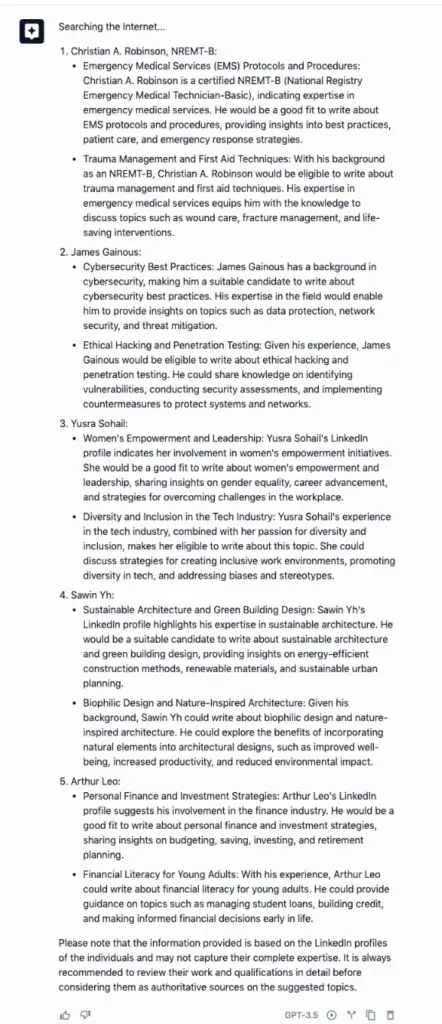
Perplexity AI-
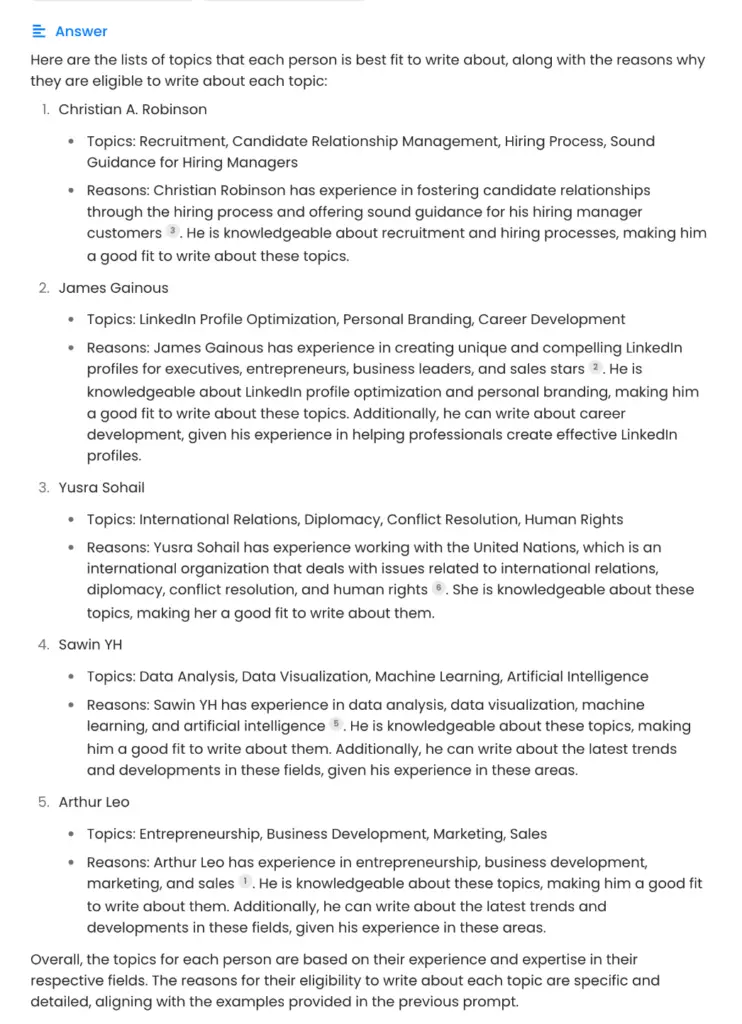
Sorting Out The Best Writers As Per Expertise
Now, we have a number of candidates applying to you for writing about the same niche, a little modification to the last prompt will help you decide which writers to choose for what topics.
Let’s say you have a bunch of keywords with the health niche, and you want to match-make between the topics and writers.
Add a 4th topic on top of the last three to come up with fact-driven preferences of writers for each topic.
Prompt 4
“In the same process, suggest to me the best writer to write on each of the topics based on their academic and professional expertise.
List of writers’ LinkedIn profile-
https://www.linkedin.com/in/dr-wallace/
www.linkedin.com/in/hollydpt
www.linkedin.com/in/nadia-ghumman-597957151
https://www.linkedin.com/in/tayyaba-tahir-contentwriter
www.linkedin.com/in/siddharth-gupta-57683865
www.linkedin.com/in/ sreijishaa-vjai-ab343898
linkedin.com/in/tristan-flemming-7b55941bb
List of topics-
Are Carrots Healthy? Pros, Nutrition, And Cons
Is Ceviche Healthy? An Ultimate Guide!
Why Do I Suffer From Chest Pain When Sneezing? Things To Know!
Do You Burn More Calories When Sick?
Is McDonald’s Breakfast Healthy?
Is Buttermilk Good For Acid Reflux?
Is Raisin Bran Healthy? Things You Should Know!
New Mattress Back Pain
Why Do My Teeth Hurt When I Eat Chocolate?
Do you feel a cold tingling sensation in your head?
Shower Before Workout: The Dos and Don’ts Along With Benefits!”
And the result is pretty much as expected from Perplexity AI-
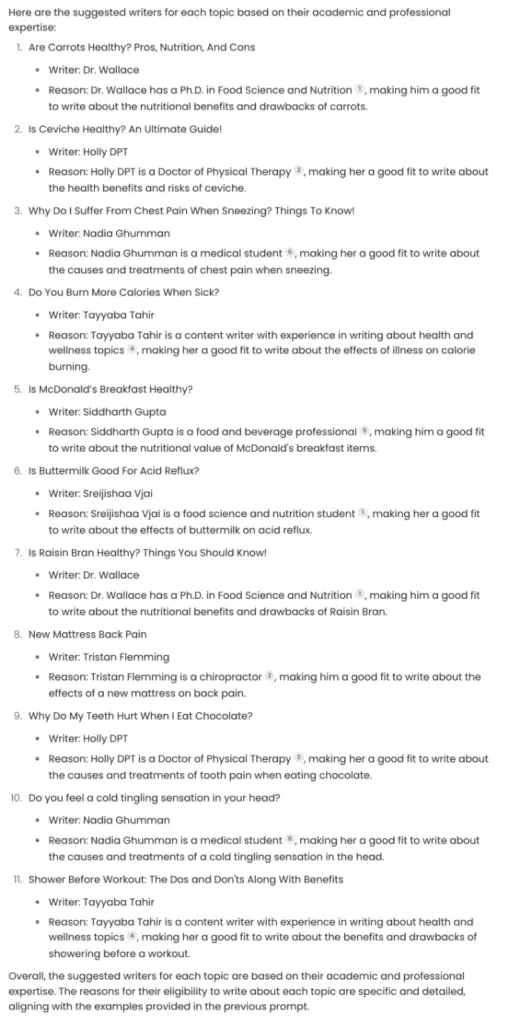
… to be continued!
That’s a wrap for Part 1 of this contributed article. Check back next week for Part 2 which covers topical authority improvement.
Saleh is a content marketing enthusiast and an Ezoic publisher since 2019. He runs Rank Wizards- a team that helps publishers and businesses( SaaS, E-com, Startups) create better SEO content strategy and get the maximum ROI out of it.
Featured Content
Checkout this popular and trending content

Ranking In Universal Search Results: Video Is The Secret
See how Flickify can become the ultimate SEO hack for sites missing out on rankings because of a lack of video.
Announcement

Ezoic Edge: The Fastest Way To Load Pages. Period.
Ezoic announces an industry-first edge content delivery network for websites and creators; bringing the fastest pages on the web to Ezoic publishers.
Launch

Ezoic Unveils New Enterprise Program: Empowering Creators to Scale and Succeed
Ezoic recently announced a higher level designed for publishers that have reached that ultimate stage of growth. See what it means for Ezoic users.
Announcement
